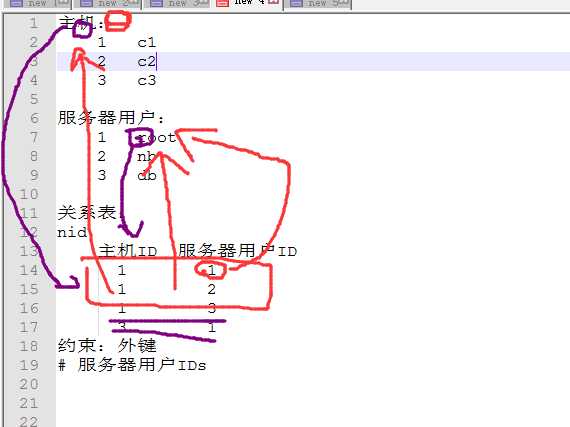标签:
First create Base class:
from sqlalchemy.ext.declarative import declarative_base Base = declarative_base()
declarative_base is a factory function, that returns a base class (actually a metaclass), and the entities are going to inherit from it.
The entities are classes, which derive from the Base class.
场景:
An image consist of a UUID and its associated number of likes. 一张图片由一个 UUID 和相关联的 like 组成
Each image can be associated with many tags, a tag can be associated with many images. 每张图片都可关联很多 tags, 每个 tag 都可以关联很多图片
That‘s a many-to-many relationship, so we need a mapping table. 图片和 tag 是多对多的关系,需要一个 mappping table 来定义对应关系
Finally each image can have multiple comments, a one-to-many relation with a foreign key on the comments side. 每张图片可以有很多 comments, 一对多关系由外键关联到 comments side.
涉及到的表:
Tag <=多对多=> Image <=一对多=> Comment
from datetime import datetime, timedelta from sqlalchemy import Table, Column, Integer, String, DateTime, ForeignKey from sqlalchemy.orm import relationship, backref tags = Table(‘tag_image‘, Base.metadata, Column(‘tag_id‘, Integer, ForeignKey(‘tags.id‘)), Column(‘image_id‘, Integer, ForeignKey(‘images.id‘)) ) class Image(Base): __tablename__ = ‘images‘ id = Column(Integer, primary_key=True) uuid = Column(String(36), unique=True, nullable=False) likes = Column(Integer, default=0) created_at = Column(DateTime, default=datetime.utcnow) # the backref parameter which adds the image properties to the tags and comments entities tags = relationship(‘Tag‘, secondary=tags, backref = backref(‘images‘, lazy=‘dynamic‘)) comments = relationship(‘Comment‘, backref=‘image‘, lazy=‘dynamic‘) def __repr__(self): str_created_at = self.created_at.strftime("%Y-%m-%d %H:%M:%S") return "<Image (uuid=‘%s‘, likes=‘%d‘, created_at=%s)>" % (self.uuid, self.likes, str_created_at) class Tag(Base): __tablename__ = ‘tags‘ id = Column(Integer, primary_key=True) name = Column(String(255), unique=True, nullable=False) def __repr__(self): return "<Tag (name=‘%s‘)>" % (self.name) class Comment(Base): __tablename__ = ‘comments‘ id = Column(Integer, primary_key=True) text = Column(String(2000)) image_id = Column(Integer, ForeignKey(‘images.id‘)) def __repr__(self): return "<Comment (text=‘%s‘)>" % (self.text)
How-to-Query:
# Get a list of tags: for name in session.query(Tag.name).order_by(Tag.name): print name # How many tags do we have? session.query(Tag).count() # Get all images created yesterday: session.query(Image) .filter(Image.created_at < datetime.utcnow().date()) .all() # Get all images, that belong to the tag ‘car‘ or ‘animal‘, using a subselect: session.query(Image) .filter(Image.tags.any(Tag.name.in_([‘car‘, ‘animal‘]))) .all() # This can also be expressed with a join: session.query(Image) .join(Tag, Image.tags) .filter(Tag.name.in_([‘car‘, ‘animal‘])) .all()
一对多:
用户表 (User)
| nid | username | group_id |
| 1 | gary | 1 |
| 2 | leon | 2 |
组表 (Group)
| nid | caption |
| 1 | dba |
| 2 | dev |
代码:
class Group(Base): __tablename__ = ‘group‘ nid = Column(Integer, primary_key=True, autoincrement=True) caption = Column(String(32)) def __repr__(self): # return str temp = "%s - %s" % (self.nid, self.caption) return temp class User(Base): __tablename__ = ‘user‘ nid = Column(Integer, primary_key=True, autoincrement=True) username = Column(String(32)) # foreign key group_id = Column(Integer, ForeignKey(‘group.nid‘)) # add relationship to Group table group = relationship("Group", backref=‘uuu‘) # uuu for 反向查找 def __repr__(self): # return str temp = "%s - %s - %s" % (self.nid, self.username, self.group_id) return temp
查找组为 dba 的所有用户,
# 正向查找组是 dba 的所有用户 ret = session.query(User).join(Group, isouter=True).filter(Group.caption == ‘dba‘).all() for obj in ret: print(obj.username, obj.group.caption) # gary dba
正向查询 query 用户表并通过 join 关联 Group 表,利用 relationship 创建的 group 虚拟字段连接 group 表
# 反向查找 # 无需去 User 表查询, 而是直接去 Group 表中查询 uuu 字段, 反向取得 dba 的组成员 obj = session.query(Group).filter(Group.caption == ‘dba‘).first() # caption 为 dba 的一行数据 print(obj.uuu[0].username, obj.caption) # gary dba
反向查找直接查询 Group 表获得 caption 为 dba 的行,然后通过 uuu 字段关联 User 表获得对应用户名
多对多:
表关系

代码:
class Host(Base): __tablename__ = ‘host‘ nid = Column(Integer, primary_key=True,autoincrement=True) hostname = Column(String(32)) port = Column(String(32)) ip = Column(String(32)) class HostUser(Base): __tablename__ = ‘host_user‘ nid = Column(Integer, primary_key=True,autoincrement=True) username = Column(String(32)) class HostToHostUser(Base): # parent __tablename__ = ‘host_to_host_user‘ nid = Column(Integer, primary_key=True,autoincrement=True) host_id = Column(Integer,ForeignKey(‘host.nid‘)) host_user_id = Column(Integer,ForeignKey(‘host_user.nid‘)) # 在关系表里定义了一个主机表 (子表) 里的虚拟字段, 指向 Host 子表 (正向), h 在子表 (Host) 里指向父表 (反向) host = relationship("Host", backref=‘h‘) # HostToHostUser.host_user 与 HostUser 对应, 指向 HostUser 子表 (正向), u 在子表 (HostUser) 里指向父表 (反向) host_user = relationship("HostUser", backref=‘u‘)
获取能够登陆 c1 主机的所有用户,
一般查找(正向):
代码:
# 找 c1 主机的主机 id host_obj = session.query(Host).filter(Host.hostname == ‘c1‘).first() # 允许登陆 c1 主机的用户 id host_2_host_user = session.query(HostToHostUser.host_user_id).filter(HostToHostUser.host_id == host_obj.nid).all() # print(host_2_host_user) # [(1,), (2,), (3,)] r = zip(*host_2_host_user) # print(list(r)[0]) # (1, 2, 3) # 把列表转成 tuple # 根据用户 id 用户查询 username users = session.query(HostUser.username).filter(HostUser.nid.in_(list(r)[0])).all() # print(users) # [(‘root‘,), (‘db‘,), (‘nb‘,)] u = zip(*users) print(list(u)[0]) # (‘root‘, ‘db‘, ‘nb‘)
反向查询:
class HostToHostUser(Base): # parent __tablename__ = ‘host_to_host_user‘ nid = Column(Integer, primary_key=True,autoincrement=True) host_id = Column(Integer,ForeignKey(‘host.nid‘)) host_user_id = Column(Integer,ForeignKey(‘host_user.nid‘)) # 在关系表里定义了一个主机表 (子表) 里的虚拟字段, 指向 Host 子表 (正向), h 在子表 (Host) 里指向父表 (反向) host = relationship("Host", backref=‘h‘) # HostToHostUser.host_user 与 HostUser 对应, 指向 HostUser 子表 (正向), u 在子表 (HostUser) 里指向父表 (反向) host_user = relationship("HostUser", backref=‘u‘)
代码:
host_obj = session.query(Host).filter(Host.hostname==‘c1‘).first() for item in host_obj.h: # 关系表中的多个对象, 原理是利用主机表里的 h 虚拟字段指向关系表里主机 id 为 1 的三行数据, 这是反向查询 # print(item.host_user.username) # print(item.host_user_id) print(item.host_user.nid, item.host_user.username) # item.host_user 通过外键与 HostUser 关联, 这是正向查询
标签:
原文地址:http://www.cnblogs.com/garyang/p/5742245.html